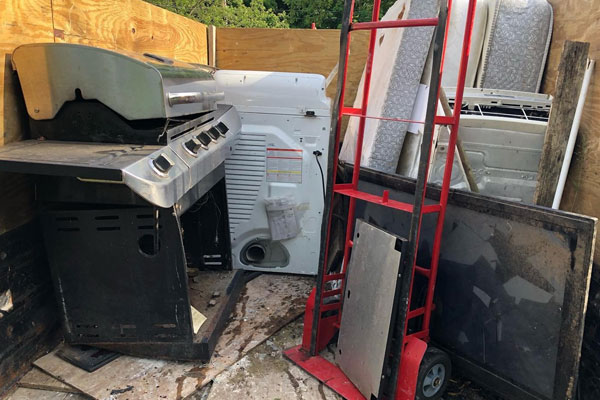
There’s a silent burden most homes carry—machines long past their prime, heavy and defiant, sitting in basements or garages. It’s easy to ignore them until they start collecting dust like a trophy of past convenience. But when it’s time to clear them out, a different kind of problem unfolds. Removal isn’t just a matter of strength; it’s wrapped in logistics, regulations, and the unpredictability of disposal procedures. Tossing an old refrigerator or rusted washer isn’t as simple as dragging it to the curb.
What many don’t realize is that appliance removal is governed by more than just local junk laws. There are safety hazards, recycling protocols, and environmental consequences baked into every rusty coil or broken compressor. Each piece tells a different story, and no two removals are ever quite the same.
Why Appliance Removal Should Never Be a DIY Job
Rolling up your sleeves and hauling out a bulky dryer might sound like a weekend challenge for the brave. But lurking behind that adventure is a cascade of unexpected turns. Old appliances often have sharp edges, leaking fluids, or live wires that betray their apparent stillness. One wrong move, and suddenly your cleanup project turns into an emergency room trip or worse.
It’s not just the danger, though. Many appliances, especially those manufactured before environmental standards evolved, contain substances that can’t simply be dumped. Think refrigerants, insulation foam, and heavy metals. The consequences of improper disposal can reach far beyond your driveway, seeping into water systems or catching penalties from local ordinances you didn’t even know existed.

The Journey Your Appliance Takes After Pickup
Once that bulky dishwasher vanishes into the back of a removal truck, what happens next is far more intricate than a simple landfill dump. First, the unit may be inspected for parts salvageable for reuse or donation. Then comes the breakdown—strip it for copper, sort the plastics, separate steel shells from motor components. Nothing is wasted without cause.
Some items are funneled into recycling centers, where machines and manual labor work in tandem to reclaim valuable materials. Others, unfit for any further use, are transported to licensed waste processing facilities. There’s an entire backstage to this process, where technicians and sorters play their part in reducing waste and minimizing environmental harm, unseen but essential.
How to Prepare Your Appliances for Professional Pickup
Before help arrives, a few thoughtful steps can make the process smoother, safer, and more efficient. Start by unplugging any cords at least 24 hours in advance. Refrigerators and freezers need time to defrost—rushing this step can lead to puddles and messes. Drain any water from dishwashers or washing machines to avoid spills during transport.
Then there’s the matter of access. Remove any obstacles between the appliance and the exit route. A narrow hallway, loose carpet, or staircase without railings could spell trouble during removal. Preparation doesn’t need to be exhaustive, but it does need to be intentional. A bit of effort upfront saves a lot of struggle later and ensures your home stays intact while the appliance exits stage left.
The Environmental Impact of Appliance Dumping
Let’s not sugarcoat it—improper appliance disposal poisons the planet. Refrigerators and air conditioners often contain chlorofluorocarbons or other ozone-depleting substances. If those escape during careless disposal, the environmental cost is steep. These aren’t hypothetical concerns; they’re real outcomes triggered by negligence or ignorance.
Even beyond the obvious pollutants, appliances left in landfills corrode over time. Rust leeches into the soil. Insulating foam releases toxic gases. Plastics don’t break down; they just scatter into micro fragments. Every shortcut taken in disposal translates into long-term consequences for water, air, and land. What looks like convenience today could become a contamination legacy tomorrow.
Cost Factors That Influence Appliance Removal Pricing
No two removal jobs are priced alike, and that’s not just marketing fluff. The cost of hauling away an old stove or washing machine depends on multiple layers. Weight is a big factor—heavier items demand more manpower and stronger equipment. Then there’s the size, which determines how much space it occupies in a removal vehicle. That space is money, plain and simple.
Disposal fees also vary based on what kind of appliance it is. A freezer might require refrigerant recovery before disposal, while a water heater could involve corrosion risks or additional labor. Some removal services bundle costs, others itemize. Either way, pricing transparency is your best friend, and the cheapest quote isn’t always the smartest choice.
Appliance Removal Laws That Most People Miss
Local Ordinances Vary Widely
Local laws governing appliance disposal are anything but uniform. Some cities allow curbside pickup of large appliances once a month, while others require you to schedule a special collection or visit an approved drop-off site. These ordinances are usually set by county or city waste departments, and they can change frequently. It’s essential to research your local rules before disposing of anything bulky or electric—assuming it can cost you in fines or missed pickups.
Permits and Proof of Licensing
Many municipalities take appliance disposal seriously enough to require permits, especially for items containing refrigerants or electronics. If you’re hiring someone to remove your appliances, some areas require proof that the hauler is licensed and insured. This protects you from liability if the appliance is dumped illegally. It also ensures the removal is done correctly, especially if hazardous materials are involved. Don’t assume your hauler is certified—ask for documentation before handing anything over.
Scheduled Bulk Pickup Restrictions
Bulk pickup days might seem like the perfect time to offload that old washing machine, but they often come with strict guidelines. Some cities don’t allow appliances with freon to be collected curbside at all. Others might require advanced scheduling or tagging. You can’t just roll something to the sidewalk and forget about it. Failure to follow bulk pickup protocols can result in non-collection, citations, or additional fees tacked onto your utility bill.
State Regulations on Hazardous Materials
When appliances contain hazardous substances like freon or mercury, disposal becomes a legal issue. Many states enforce laws requiring certified technicians to remove and document these materials before the appliance can be scrapped. For example, tossing a fridge without extracting freon isn’t just discouraged—it could lead to fines or prosecution. These rules are in place to protect air quality and groundwater, and violating them—even unknowingly—won’t excuse you in the eyes of the law.
Documentation and Disposal Receipts
Some states and municipalities expect homeowners or businesses to retain documentation proving that appliances were legally and responsibly disposed of. This can include receipts from certified recycling centers, freon extraction reports, or paperwork from licensed haulers. Holding onto these records can protect you if questions arise later—especially for landlords, contractors, or property managers. Think of it like a paper trail that proves you didn’t just dump that old dryer in a random alley.
The Perks of Choosing a Full-Service Removal Company
When a company offers full-service appliance removal, they’re not just offering muscle—they’re offering peace of mind. From arrival to final sweep-up, the process unfolds with calculated efficiency. They bring tools, dolls, pads, and protective gear. They’ve already read the rulebook, so you don’t have to. And they know the recycling centers from the landfills, so nothing ends up in the wrong place.
It’s not just the physical work being outsourced—it’s the stress. There’s no coordinating with multiple services, no worrying about what happens next. A reputable removal company handles the logistics, the legal compliance, and the disposal trail so you can focus on reclaiming your space without second-guessing the process every step of the way.
What Makes an Appliance Removal Company Trustworthy
It’s not just about trucks and muscle—trust in the junk removal world comes down to reliability, clarity, and reputation. A worthy company shows up on time, communicates clearly, and offers transparent pricing without hidden fees that sneak up later. Their staff doesn’t treat your property like a playground. They navigate with caution, act with respect, and follow through on what they promise.
Look deeper, and you’ll see ethics at play. Are they eco-conscious? Do they recycle when possible, or just dump and dash? Do they hold certifications for handling refrigerants or hazardous waste? A solid removal company will have answers—not excuses—when asked about their process. That’s how you separate pros from pretenders.
How Appliance Removal Fits into a Larger Decluttering Strategy
Tackling a single appliance might seem like a one-off task, but it often kickstarts a bigger transformation. Removing that old washing machine or obsolete oven suddenly reveals extra room. That extra room often prompts bigger decisions. What else can go? What’s truly useful, and what’s just occupying square footage out of habit?
Before long, a pattern emerges. Appliance removal turns into furniture reassessment, then maybe garage clearing or attic sorting. It’s a snowball effect—the kind that leads to a clearer, cleaner living space. And each step reinforces the sense that you’re reclaiming control over your environment instead of just reacting to the clutter you’ve learned to tolerate.
Conclusion
Appliance removal isn’t just about lifting and loading. It’s a process shaped by safety, legality, environmental concern, and logistical planning. While it may appear simple from the outside, each item carries hidden challenges and responsibilities. Attempting it alone can quickly spiral into something far more complicated—and dangerous—than anticipated. From understanding local disposal laws to coordinating safe extraction and eco-responsible disposal, the path isn’t one to walk without proper support.
For residents seeking a reliable and responsible solution, 606 Junk Removal and Dumpster Rental offers comprehensive appliance removal services tailored to the needs of Chicago homeowners. With expert knowledge, proper licensing, and a commitment to safe, eco-conscious practices, they’re the trusted name for clearing your space with confidence. To schedule a pickup or inquire further, contact them at 773-412-4902 or email info@606junk.com.
